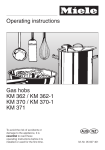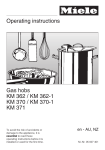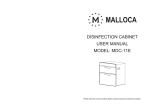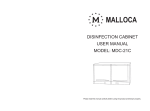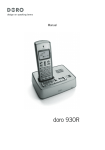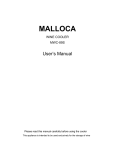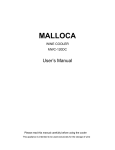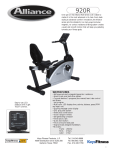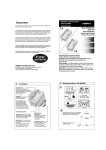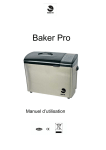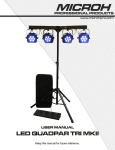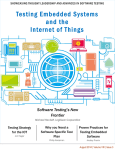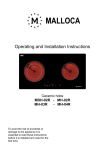Download Operating and Installation Instructions
Transcript
Operating and Installation Instructions AS 920GR/R/MB - AS 930G/R/B AS 9402B/BG/G/R - AS 9403B/G/R GHG 732A NEW - GHG 733B/C NEW AS 920 - AS 930 AS 920L - AS 930L AS 9202 - AS 9203 DG 01 - DG 02 To avoid the risk of accidents or damage to the appliance it is essential to read these instructions before it is installed and used for the first time. Contents Contents AS 920GR/R/MB Description of the appliance............................................................................04 DG 02 AS 930G/R/B Description of the appliance............................................................................06 Installation..................................................................................................................32 AS 9402B/BG/G/R Description of the appliance............................................................................08 AS 9403B/G/R Description of the appliance............................................................................10 GHG 732A NEW Description of the appliance............................................................................12 GHG 733B/C NEW Description of the appliance............................................................................14 Description of the appliance............................................................................30 Warning and Safety instructions................................................................................34 Before using for the first time.....................................................................................41 Using the appliance...................................................................................................42 Cleaning and care.....................................................................................................47 Problem solving guide...............................................................................................51 After sales service.....................................................................................................52 AS 920 Description of the appliance............................................................................16 AS 930 Description of the appliance............................................................................18 AS 920L Description of the appliance............................................................................20 AS 930L Description of the appliance............................................................................22 AS 9202 Description of the appliance............................................................................24 AS 9203 Description of the appliance............................................................................26 DG 01 2 Description of the appliance............................................................................28 3 Description of the appliance Description of the appliance Model Burners AS 920GR/R/MB 6 3 4 5 4 3 2 1 1 Controls 1 Left 2 Right 2 1 2 3 4 3 4 4 Burner Pan support 5 6 Ignition electrode Thermocouple Burner body Crown External cap Internal cap 5 Description of the appliance Description of the appliance Model Burners AS 930G/R/B 6 5 7 6 8 5 11 4 10 3 9 2 8 1 1 Controls Left 2 Middle 3 Right 4 Timer (for right burner) 1 2 3 7 4 1 2 3 4 5 5 6 7 8 6 Large burner Small burner 6 Ignition electrode Burner body Thermocouple Crown External cap Internal cap 7 8 9 10 11 Burner body Thermocouple Ignition electrode Crown Cap Small pan support Large pan support 7 Description of the appliance Description of the appliance Model Burners AS 9402B/BG/G/R 6 4 5 5 4 3 2 1 Controls 1 Left 2 Right 3 Timer (for right burner) 4 5 Burner Pan support 2 3 1 1 2 3 4 5 6 8 Ignition electrode Thermocouple Burner body Crown External cap Internal cap 9 Description of the appliance Description of the appliance Model Burners AS 9403B/G/R 6 5 7 6 8 5 11 4 10 3 1 Controls 1 Left 2 Middle 3 Right 4 Timer (for right burner) 5 6 7 8 10 Large burner Small burner 2 3 9 2 8 1 7 4 1 2 3 4 5 6 Ignition electrode Thermocouple Burner body Crown External cap Internal cap 7 8 9 10 11 Burner body Thermocouple Ignition electrode Crown Cap Small pan support Large pan support 11 Description of the appliance Description of the appliance Model Burners GHG 732A New 6 3 4 5 4 3 2 1 1 Controls 1 Left 2 Right 3 4 Burner Pan support 2 1 2 3 4 5 6 12 Ignition electrode Burner body Thermocouple Crown External cap Internal cap 13 Description of the appliance Description of the appliance Model Burners GHG 733B/C New 6 4 7 5 8 6 5 11 16 4 10 15 3 9 2 1 1 2 2 4 5 6 7 8 14 13 7 12 3 1 Controls 1 Left 2 Middle 3 Right 14 8 3 4 5 6 Burner body Ignition electrode Thermocouple Crown External cap Internal cap 7 8 9 10 11 Ignition electrode Burner body Thermocouple Crown Cap 12 13 14 15 16 Thermocouple Burner body Ignition electrode Crown Cap Large burner Small burner Medium burner Small pan support Large pan support 15 Description of the appliance Description of the appliance Model Burners AS 920 3 5 4 6 12 5 11 4 10 3 9 2 8 1 1 Controls 1 Left 2 Right 3 4 5 16 Medium burner Large burner Pan support 7 2 1 2 3 4 5 6 Burner body Thermocouple Ignition electrode Crown External cap Internal cap 7 8 9 10 11 12 Ignition electrode Thermocouple Burner body Crown External cap Internal cap 17 Description of the appliance Description of the appliance Model Burners AS 930 4 7 5 8 6 17 5 16 6 11 15 10 4 9 3 14 8 2 13 7 12 1 1 Controls 1 Left 2 Middle 3 Right 2 3 1 2 3 4 5 4 5 6 7 8 18 Medium burner Small burner Large burner 6 Burner body Thermocouple Ignition electrode Crown External cap Internal cap 7 8 9 10 11 Burner body Ignition electrode Thermocouple Crown Cap 12 13 14 15 16 17 Ignition electrode Thermocouple Burner body Crown External cap Internal cap Small pan support Large pan support 19 Description of the appliance Description of the appliance Model Burners AS 920L 5 6 7 5 4 3 2 1 Controls 1 Left 2 Right 3 Timer (for right burner) 4 5 Burner Pan support 2 3 1 1 2 3 4 5 6 20 Ignition electrode Thermocouple Burner body Crown External cap Internal cap 21 Description of the appliance Description of the appliance Model Burners AS 930L 6 5 7 6 8 5 11 4 10 3 1 Controls 1 Left 2 Middle 3 Right 4 Timer (for right burner) 5 6 7 8 22 Large burner Small burner 2 3 4 9 2 8 1 7 1 2 3 4 5 6 Ignition electrode Thermocouple Burner body Crown External cap Internal cap 7 8 9 10 11 Burner body Thermocouple Ignition electrode Crown Cap Small pan support Large pan support 23 Description of the appliance Description of the appliance Model Burners AS 9202 6 5 3 4 5 12 11 4 10 3 9 8 2 7 1 1 Controls 1 Left 2 Right 3 4 5 24 Large burner Medium burner Pan support 2 1 2 3 4 5 6 Burner body Ignition electrode Thermocouple Crown External cap Internal cap 7 8 9 10 11 12 Thermocouple Ignition electrode Burner body Crown External cap Internal cap 25 Description of the appliance Description of the appliance Model Burners AS 9203 6 5 8 6 9 7 18 5 12 17 11 4 16 10 3 15 9 2 8 14 7 13 1 1 2 3 4 1 2 Controls 1 Left 2 Middle 3 Right 4 Timer (for right burner) 5 6 7 8 9 26 3 4 5 6 Burner body Ignition electrode Thermocouple Crown External cap Internal cap 7 8 9 10 11 12 Thermocouple Ignition electrode Burner body Crown External cap Internal cap 13 14 15 16 17 18 Burner body Thermocouple Ignition electrode Crown External cap Internal cap Medium burner Small burner Large burner Small pan support Large pan support 27 Description of the appliance Model Description of the appliance Burners DG 01 6 5 3 4 2 3 2 1 1 1 2 3 Control Burner Pan support 1 2 3 4 5 6 28 Burner body Thermocouple Ignition electrode Crown External cap Internal cap 29 Description of the appliance Description of the appliance Model Burners DG 02 6 6 5 11 4 10 4 5 9 3 3 8 2 7 1 1 Controls 1 Front 2 Back 3 4 5 6 30 Small burner Large burner 2 1 2 3 4 5 6 Burner body Thermocouple Ignition electrode Crown External cap Internal cap 7 8 9 10 11 Burner body Ignition electrode Thermocouple Crown Cap Small pan support Large pan support 31 Installation Installation Cut-out Important Make the countertop cut-out following the dimensions given in the illustration. This appliance should be installed with plenty of space on either side. 850 Gas connection 490 Connection to the gas supply, or conversion from one type of gas to another should only be undertaken by an approved and registered gas installer in strict accordance with local and national safety and building regulations. Every appliance should have its own isolating valve and test point. 790 440 Check with your local gas supplier about the type of gas and its calorific value, and compare this information with the type of gas quoted on the hob data plate. The installer is responsible for ensuring that the appliance functions correctly when installed. The gas installation must be made in such a way that the isolating valve is visible and easily accessible after the appliance has been built in. A test for possible leakages must be carried out after installation. 32 Model Cut-out dimension AS 920GR/R/MB 665 * 385 mm AS 930G/R/B 745 * 415 mm AS 9402B/BG/G/R - AS9403B/G/R 790 * 440 mm GHG 732A NEW - GHG 733B/C NEW 660 * 360 mm AS 920 660 * 360 mm AS 930 665 * 385mm AS 920L - AS 930L 790 * 440 mm AS 9202 660 * 360mm AS 9203 680 * 380 mm DG 01 - DG 02 280 * 460mm Safety regulations demand that a pressure test nipple is installed near a gas hob to allow an engineer to test the pressure following servicing. 33 Warning and Safety instructions Gas-heated appliance Safety precautions to take if you smell gas - Turn off the gas emergency control valve immediately. This is usually located near the gas meter. - Eliminate all sources of ignition in a safe manner. Do not smoke, light cigarette lighters or matches. Warning and Safety instructions To avoid the risk of accidents and damage to the appliance, please read these instructions carefully before using it for the first time. They contain important notes on its installation, safety, use and maintenance. The use of the appliance by the elderly or infirm or those who have not used the appliance before should be supervised by a competent and responsible person to avoid the risk of injury. - Do not operate electrical lights or switches, i.e. do not switch them “On” or “Off”. Keep these instructions in a safe place for reference, and pass them on to any future user. - Open all doors and windows to ventilate the area. Installation and connection - If the smell of gas persists, evacuate the building. The connection to the gas supply must be carried out by a suitably qualified and competent person in strict accordance with current local and national safety regulations. Malloca cannot be held liable for damage caused by incorrect installation or connection. Ensure that the gas pipe is installed in such a way that it does not touch any parts of the appliance which become hot. This could cause damage. 34 35 Warning and Safety instructions Warning and Safety instructions Correct usage Safety with children For safety reasons this appliance must only be operated after it has been built in. This is necessary to ensure that all electrical components are shielded. The appliance is only intended for use by adults who have read these Operating instructions. This appliance is intended for domestic use only and is not to be used for commercial purposes. This appliance is not a toy! To avoid the risk of injury, keep children well away, and do not allow them to play with it or use the controls. They will not understand the potential dangers posed by it. They should be supervised whenever you are working in the kitchen. Use this appliance for the preparation of food only. Any other usage is at the owner’s risk and could be dangerous. Malloca cannot be held liable for damage resulting from incorrect or improper use or operation. Do not use the appliance to heat up the room. Due to the high temperatures radiated, objects near the appliance could catch fire. The life of the appliance could also be reduced. Using the appliance will cause a build-up of heat and moisture in the room in which it is installed. Ensure that the room has sufficient natural or mechanical means of ventilation, e.g. an cooker hood. If the appliance is used for very long periods of time, additional ventilation of the room may be necessary, e.g. by opening windows or doors, or running the cooker hood on the highest setting. This appliance must not be set up or operated in the open air. Make sure all the components of the gas burner have been correctly assembled before switching on. When using the appliance, ensure that any burners in use are always covered with a pan. If using a cooker hood above it flames could be drawn up by the suction of the cooker hood, parts of which could then be damaged or even set on fire. Older children may use the appliance only when its operation has been clearly explained to them and they are able to use it safely, recognizing the dangers of misuse. The appliance gets hot when in use and remains hot for quite a while after being switched off. To safeguard against burning, keep children well away from the appliance at all times. Do not store anything which might arouse a child’s interest in storage areas above or next to the appliance. Otherwise they could be tempted into climbing onto the appliance with the risk of burning themselves. Keep all pans out of reach of children. Turn pan handles inwards away from the edge of the hob. Danger of burning or scalding. Packaging, e.g. cling film, polystyrene and plastic wrappings,must be kept out of the reach of babies and young children. Danger of suffocation. Dispose of or recycle all packaging safely as soon as possible. Before disposing of an old appliance, disconnect it from the gas supplies. Cut off and render any plug useless. Cut off the cable directly behind the appliance to prevent misuse. This should be done by a competent person. Pans must be the correct size for the burner they are used on (see “Suitable pans”). A pan which is too small will be unstable on the pan support. If the pan diameter is too large flames can spread out to the sides and damage or burn the worktop, wall claddings or surrounding units and also parts of the hob. Malloca cannot be held liable for this type of damage. Do not store any inflammable objects near the appliance. 36 37 Warning and Safety instructions Warning and Safety instructions Protecting the appliance from damage Protection from burning Unless the pan manufacturer states that you can do so, do not use pans with very thin bases on this hob, and never heat up empty pans as they could get damaged. This could also damage the appliance. The appliance gets hot when in use, and remains hot for quite a while after being switched off. Do not touch it whilst it could still be hot. There are areas which may be subject to infestation by cockroaches or other vermin, pay particular attention to keeping the appliance and its surroundings in a clean condition at all times. Any damage which may be caused by cockroaches or other vermin will not be covered by the appliance guarantee. For added protection, it is advisable to use heat-resistant pot holders or oven gloves when using the appliance. Ensure that they do not come into contact with the flames. Do not use large cloths, tea towels or similar as the ends could touch the flames and catch fire. Take care not to let the gloves get damp or wet, as this causes heat to transfer through the material more quickly with the risk of burning yourself. Do not heat up unopened tins of food on the hob. Presssure can build up and they may explode, resulting in injury and scalding or damage. Do not use the appliance as a resting place for anything else. The article could melt or catch fire if residual heat is still present or if the appliance is switched on by mistake. Do not cover the appliance, e.g. with a cloth, kitchen foil, etc. This could be a fire hazard if the appliance is switched on by mistake. Remove splashes of fat and other food debris from the surface as soon as possible. These are a fire hazard. Never leave the appliance unattended when cooking with oil or fat. Very hot oil can catch fire and could even set a cooker hood above on fire. Always heat fat slowly, watching as it heats. If, despite this, oil or fat does catch fire, do not attempt to put out the flames with water. Use a suitable fire blanket, saucepan lid, damp towel or similar to smother the flames. Do not flambé under a cooker hood. The flames could set the cooker hood on fire. Ensure that the flames from the burner do not spread out beyond the base and up the sides of the pan. 38 39 Warning and Safety instructions Before using for the first time Appliance faults Cleaning and heating up for the first time In the event of damage or a defect, switch off the appliance immediately. Turn off the gas supply tap. It should not be used again until it has been repaired. Do not reconnect the appliance to the main gas supply until after it has been repaired. Before using for the first time clean the hob and all removable parts as follows: Repairs to the gas components of this appliance must only be carried out by a suitably qualified person. Repairs and other work by unqualified persons could be very dangerous and could damage the appliance. Malloca cannot be held liable for unauthorised work. Never open the housing of the appliance. - The removable parts of the gas burner assembly can be washed in a mild solution of water and washing-up liquid. Wipe dry and reassemble in the correct order (see “Cleaning and care”). - Clean the stainless steel surface with a damp cloth only, and then wipe dry. While the appliance is under guarantee, repairs should only be undertaken by a service engineer authorised by Malloca. Otherwise the guarantee is invalidated. Metal components have a protective coating which may give off a slight smell when heated up for the first time. The smell and any vapours will dissipate after a short time and do not indicate a faulty connection or appliance. Further safety notes Disposal of packing material When using an electric socket near the appliance, care should be taken that the cable of the electrical appliance does not come into contact with the hot appliance. The insulation on the cable could become damaged, giving rise to an electric shock hazard. The transport and protective packing has been selected from materials which are environmentally friendly for disposal and can normally be recycled. Do not use plastic or aluminium foil containers.These melt at high temperatures and could catch fire. Packaging, e.g. cling film, polystyrene and plastic wrappings, must be kept out of the reach of babies and young children. Danger of suffocation. Dispose of or recycle all packaging materials safely as soon as possible. Spray canisters, aerosols and other inflammable substances must not be stored in a drawer under the hob. Cutlery inserts must be heat-resistant. If the appliance has not been used for a longer period of time it should be thoroughly cleaned before it is used again. It is also advisable to have the appliance tested for safety. This should be done at regular intervals. Malloca cannot be held liable for damage caused by non-compliance with these Warning and Safety instructions. 40 41 Using the appliance Using the appliance Switching on, adjusting the flame and switching off To adjust the flame: The control is used to switch on the burner and regulate the strength of the flame. Once the flame is burning well (after letting the control go), select a setting between the twin and single flame symbols. The flame will become weaker when the control is turned anti-clockwise and stronger when it is turned clockwise. It is not necessary to press in the control when adjusting the setting. Control the flame so that it does not spread out beyond the sides of the pan. As the outer part of the flame is much hotter than the centre, the tips of the flames should stay beneath the pan base. Flame tips which extend beyond the sides of the pan merely warm up the air in the room and can also damage pan handles and increase the danger of injury. The gas supply is turned off strong flame weak flame The burners can only be switched on by pressing in the appropriate control and turning it anti-clockwise, and switched off by turning the control clockwise. - Trying to switch on a burner without pressing in the control, - Switching on a burner by turning it clockwise, or - Switching off a burner by turning it anti-clockwise, can damage components in the appliance. Malloca cannot be held liable for this type of damage. To swtich off Turn the control clockwise to position “ “. This stops the flow of gas and the flame goes out. To switch on: The control for the burner required must be pressed in and turned anti-clockwise to the twin flame symbol to switch on. When the flame ignites, keep the control pressed in for 8-10 seconds, and then let it go. If the flame goes out, repeat the procedure, keeping the control pressed in for a few extra seconds. 42 43 Using the appliance Using the appliance Suitable pans You should select pans which are suitable for the burner they are to be used on. In general: use larger diameter pans on the large burner and smaller diameter pans on the small burner. Model Burner Power(kw) Min. pan base diameter (cm) Max. pan base diameter (cm) 9402B/BG/G/R 920L 732A New Large 3.8 * 2 14 26 9403B/G/R 930L Large Small 3.8 * 2 1.0 * 1 14 10 26 20 920R/GR/MB Wok 4.5 * 2 14 30 930R/G/B Wok Small 4.5 * 2 1.0 * 2 14 10 30 20 Large Medium Small 3.8 * 1 3.0 * 1 1.0 * 1 14 14 10 26 24 20 920 Large Medium 3.8 * 1 2.5 * 1 14 14 26 24 930 Large Medium Small 3.8 * 1 2.5 * 1 1.5 * 1 14 14 12 26 24 22 9202 Large Medium 3.4 * 1 2.4 * 1 14 14 26 24 9203 Large Medium Small 3.4 * 1 2.4 * 1 1.4 * 1 14 14 12 26 24 22 DG 01 Large 3.8 * 1 14 26 DG 02 Medium Small 2.5 * 1 1.5 * 1 14 14 24 22 733B/C New 44 Wide, shallow pans are preferable to tall, narrow ones. They will heat up faster. Pans with thick bases are preferable as these distribute heat more evenly, and therefore lessen the risk of heat spots occurring which can cause food to stick or burn. With thin bases heat is conducted quickly to the food, however there is a danger of food heating up unevenly and too quickly increasing the risk of burning. Stir the food frequently. Any heat-resistant pans can be used on a gas burner. Remember when purchasing new pans that manufacturers usually refer to the diameter at the top of the pan in their documentation. Refer to the chart above and ensure that the pan diameter falls within the minimum and maximum diameters given for the burner you are using. A pan which is too small will be unstable on the pan support. If the pan diameter is too large flames can spread out to the sides and damage or burn the worktop, wall claddings or surrounding units and also parts of the hob. The manufacturer cannot be held liable for this type of damage. Use a pan lid whenever possible to minimise heat loss. 45 Using the appliance Cleaning and care Safety cut-out General notes This appliance is fitted with a thermoelectric ignition safety device which cuts off the supply of gas to a burner if the flame goes out, for example if food has boiled over, or if there was a sudden draught. Clean the appliance regularly, preferably after each use. Allow the appliance to cool down to a safe temperature before cleaning. To use the burner again, turn the control clockwise to the “ normal. ” position and switch on as The safety cut-out operates independently from the battery supply. This means that it will still work if the battey run out. Using your hob during a battery run out If there is an interruption to the battery supply the gas can be ignited with a match: - Press in the relevant control and turn it anti-clockwise to the large flame symbol. Do not use any sharp pointed objects which could damage the seal between the glass surface and the worktop. Do not let the ignitor in the burner get wet. If it gets wet it will not spark. After cleaning, dry the surfaces thoroughly with a soft cloth to prevent a build-up of limescale deposits. Pan supports, controls Remove the pan supports. - Hold the control pressed in and light the gas at the burner with a match. The pan supports and the controls can be cleaned with a solution of warm water and a little washing up liquid applied with a soft sponge. Soak stubborn soiling first to loosen it. - Keep the control pressed in for a further 8-10 seconds and then release it. Finally, wipe dry using a soft cloth. 46 47 Cleaning and care Cleaning and care Glass surfaces Spillages etc. should be cleaned off as soon as possible. 6 Most soiling can be wiped off using a damp cloth. Stubborn soiling may need to be removed with a shielded scraper blade. 5 6 5 To remove any limescale deposits, caused for example by water boiling over and metallic marks (aluminium deposits) apply a few drops of a proprietary cleaning agent for glass surfaces using a soft cloth or kitchen paper towel. Note that some cleaning agents contain a protective additive designed to prevent water marks and smears adhering to the surface. After cleaning wipe the hob surface with a damp cloth and then dry it with a clean soft cloth. Burners 4 4 3 3 2 2 1 1 The burners can be dismantled for cleaning once they have cooled down. Proceed as follows: - Take off all the removable parts of the burner and wash in a solution of hot water and washing-up liquid. Then dry them all thoroughly. Make sure that the flame slits are clean and completely dry. Re-assemble the burner as follows: The surface of the burner cap will gradually become more matt with time. This is quite normal and will not affect the operation of the hob. - Place the crown 4 onto the burner body 1 so that the thermocouple 3 and the ignition electrode 2 extend through their respective holes in the crown. The crown must click into place correctly. - Wipe the fixed parts of the burner base with a damp cloth and dry afterwards. - Place the external cap - Gently wipe the ignitor and the ignition safety device with a clean cloth. Important: replace parts in the correct order after cleaning. 48 5 and internal cap 6 in position. 49 Cleaning and care 5 Problem solving guide Repairs to the gas components of this appliance must only be carried out by a suitably qualified and competent person in strict accordance with current local and national safety regulations to ensure safety. Repairs and other work by unqualified persons could be dangerous. Malloca cannot be held liable for unauthorized work. What to do if ... the burner does not ignite after several attempts Check whether 4 - The burner is correctly assembled. - The gas supply tap is turned on. 3 2 1 - The burner is dry and clean. - The flame slits are dry and unblocked. ... the gas flame goes out after being lit Check whether the burner cap is correctly positioned. ... the ignitor on the burner does not spark Re-assemble the burner as follows: - Place the crown 4 onto the burner body 1 so that the thermocouple 3 and the ignition electrode 2 extend through their respective holes in the crown. The burner head must click into place correctly. - Place the cap 5 flat over the crown . When correctly positioned it will not slide about. Check whether food deposits have lodged themselves between the ignitor and the burner cap. Carefully remove any soiling. Do not let the ignitor get wet. ... the flame suddenly looks different Check whether the burner is correctly assembled. Important: replace parts in the correct order after cleaning. 50 51 After sales service In the event of any faults which you cannot remedy yourself, or if the appliance is under guarantee, please contact: – Malloca dealer, or EXCLUSIVE DISTRIBUTOR IN VIETNAM BACH HOP KITCHEN APPLIANCES CO., LTD – Malloca Technical Service Department (see back cover for address). When contacting Malloca Technical Service Department, please quote the model and serial number of your appliance swhich are given on the data plate. 52 Office and Showroom: 279 Nguyen Van Troi St., Ward 10, Phu Nhuan Dist., HCM City Tel: (84) 8 39975 893 - (84) 8 39975 894 Fax: (84) 8 39970 135 Email: [email protected]



























